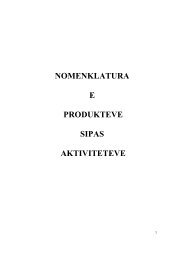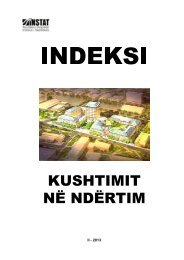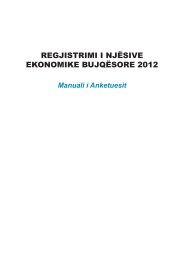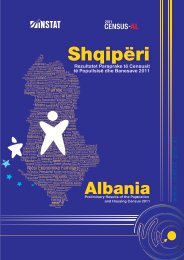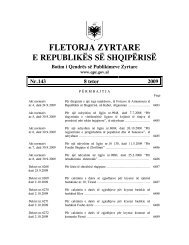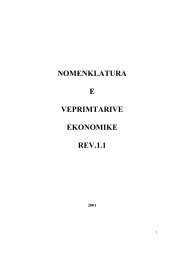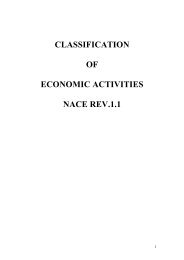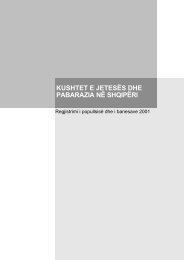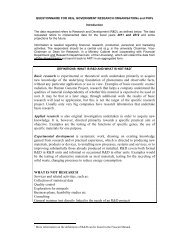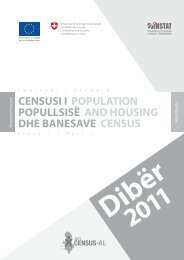Description of methods and sources for Albania - INSTAT
Description of methods and sources for Albania - INSTAT
Description of methods and sources for Albania - INSTAT
- No tags were found...
Create successful ePaper yourself
Turn your PDF publications into a flip-book with our unique Google optimized e-Paper software.
IPA 2009 Multi-beneficiary StatisticalCooperation ProgrammeCHAPTER 7: EXHAUSTIVENESS ADJUSTMENTS OF GDP BYPRODUCTION APPROACH7.1. IntroductionTo ensure exhaustiveness <strong>of</strong> GDP estimates, the staff <strong>of</strong> National AccountsDirectorate has used the so-called “expert” method to measure economicunderground activities by using existing data <strong>sources</strong> covering the period 1996-2003.The method is based on experts’ opinions where they assess the share <strong>of</strong> NOE ineach branch <strong>of</strong> economic activity. This share is then used <strong>for</strong> grossing up data onoutput, intermediate consumption <strong>and</strong> value added <strong>for</strong> each branchThe production approach to estimate GDP, the methodology currently adopted <strong>for</strong>NOE estimations, suffers from a high degree <strong>of</strong> subjectivity. For this reason,<strong>INSTAT</strong> <strong>Albania</strong> plans to improve it <strong>and</strong> shift to a new methodology mainly basedon a statistical approach. This will be done with the help <strong>of</strong> two different projectsaimed to provide technical assistance to <strong>INSTAT</strong> in the field <strong>of</strong> National Accounts.The projects are funded by the EU Commission (through the CARDS programme)<strong>and</strong> by the IMF.The twinning project between <strong>INSTAT</strong> <strong>and</strong> the Statistical Institute <strong>of</strong> Italy (ISTAT),which was started in 2004, provides assistance <strong>for</strong> the improvement in estimation <strong>of</strong>the non-observed economy in <strong>Albania</strong>, by developing <strong>and</strong> testing a methodology <strong>for</strong>NOE estimation based on the Italian approach <strong>of</strong> the labor input method. The newmethod is used starting with the figures <strong>of</strong> years 2001-2002-2003.7.2 Input <strong>of</strong> labor, <strong>sources</strong> <strong>of</strong> in<strong>for</strong>mationEstimates <strong>of</strong> employment are used to achieve exhaustiveness in national accounts bytaking into consideration the non-observed economy. In<strong>for</strong>mation <strong>sources</strong> thatcontribute to estimate <strong>of</strong> labor input are classified on basis <strong>of</strong> statistical units thatprovide in<strong>for</strong>mation <strong>of</strong> <strong>sources</strong> on labor dem<strong>and</strong> (which are the Annual StructuralBusiness Survey <strong>and</strong> Annual Accounts Statements) <strong>and</strong> <strong>sources</strong> on labor supply(Census <strong>of</strong> 2001 <strong>and</strong> LSMS ).7.2.2. Sources <strong>of</strong> data <strong>for</strong> the supply <strong>of</strong> laborIn the benchmark year 2001 the main source <strong>of</strong> in<strong>for</strong>mation on the labor market in<strong>Albania</strong> was the Population <strong>and</strong> Housing Census <strong>of</strong> 2001. It gave quite a completeenumeration <strong>of</strong> population <strong>and</strong> employment in the country.The source <strong>of</strong> in<strong>for</strong>mation <strong>of</strong> labor market <strong>for</strong> the following years 2002-2005 hasbeen the Living St<strong>and</strong>ard Measurement Survey (LSMS). This is a sample survey(3660 households) covering all districts <strong>of</strong> the country. This annual multipurposesurvey is mainly oriented to measure the households’ living st<strong>and</strong>ard in the country.103/236



